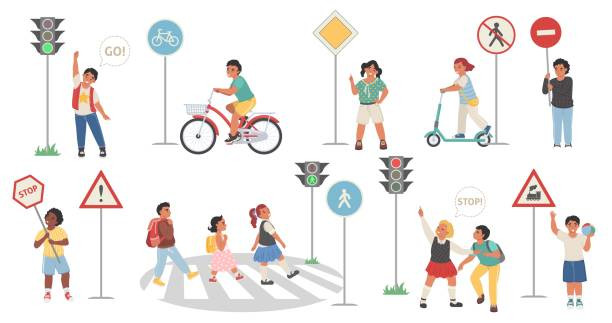Deciphering Road Signs: Unlocking the Secrets for Safer Driving
Introduction
Navigating the roads is akin to learning a new language, where each sign has a specific message designed to guide and safeguard drivers. For novices and even seasoned drivers, deciphering these road signs can sometimes be a challenging puzzle. Diving into the complexities and subtleties of road signage, this exploration will illuminate how a thorough understanding of their meanings not only enhances driving safety but also enriches the overall driving experience. By mastering this 'language,' drivers can navigate more confidently and efficiently, making informed decisions that ensure their safety and the safety of others sharing the road.
Understanding Road Signs: The Basics
The world of road signage is designed to be intuitive, but it’s not uncommon to find yourself second-guessing a sign’s message. To clear up any confusion and help you make quick, informed decisions on the road, here are a few strategies:
Recognize the Patterns: Road signs use consistent color and shape patterns to indicate their function. Once you recognize these patterns, you can quickly understand what’s expected without having to slow down.
Hit the Books: Regularly reviewing your state’s driving manual is more than preparation for your driving test; it’s a way to refresh your understanding of what different road signs mean.
Practice Regularly: Like any language, practice is key. Use driving simulators, take practice tests, and stay observant while on the road to sharpen your sign-reading skills.
The Language of Colors and Shapes
The intricate language of road signs is communicated through specific colors and shapes, each meticulously designed to convey critical information efficiently and effectively, especially when drivers need to make quick decisions while traveling at high speeds. Understanding this visual language is crucial as each color and shape serves a distinct purpose: red commands attention for stop signals and prohibitions, green guides and informs route options, blue offers details about services and facilities, yellow cautions about potential hazards, and orange warns of construction zones ahead. Shapes too play a vital role; octagons signal stopping, triangles indicate yielding, rectangles provide general information or instructions, diamonds warn of upcoming hazards, and circles typically denote railroad crossings. This carefully structured system ensures that regardless of the language spoken by the driver, the signs convey a universal message that is understood instantly, maintaining order and safety on the roads. By learning to interpret these colors and shapes accurately, drivers can navigate more confidently and respond correctly to the diverse scenarios they encounter on their journeys, enhancing both their safety and that of others on the road. Here’s a quick guide to what these colors and shapes generally mean:
Colors:
Red: This color is used for signs that require drivers to stop or yield, indicating prohibited actions.
Yellow: Often seen on warning signs, yellow signals caution, alerting drivers to potential hazards or changes in road conditions.
Green: This color is synonymous with go, used on signs that give directions, distances, and navigation information.
Blue: Look for blue signs when you need information on services like rest stops, hospitals, and more.
Orange: Orange is the color of construction and detour signs, indicating temporary conditions ahead.
Black and White: These colors are typically used for regulatory signs, such as speed limits and parking regulations.
Shapes:
Octagon: Reserved exclusively for stop signs.
Triangle: Used for yield signs, indicating that drivers need to slow down and be prepared to stop.
Rectangle: These are common for informational signs like directions and regulations.
Diamond: Warning signs, alerting drivers to conditions such as curves, crosswalks, or road work.
Pentagon: Watch for these near schools, where children are likely to cross.
Circle: You’ll see these at railroad crossings.
Pennant: This shape warns drivers of no-passing zones ahead.
Enhancing Understanding Through Driver Education
Effective driver education extends beyond mere vehicle operation; it equips learners with the skills necessary to accurately interpret and respond to road signs. At Get Drivers Ed, our approach involves an exhaustive exploration of road sign meanings to thoroughly prepare drivers for real-world driving scenarios. Our curriculum covers everything from recognizing pedestrian crossings to navigating complex interchanges, ensuring that drivers develop a comprehensive understanding that instills confidence behind the wheel. This detailed education helps learners transform their approach to driving, turning them from tentative participants into proficient navigators of the roadways.
Conclusion
A profound understanding of road signs significantly enhances the safety and efficiency of your driving experience. These signs are indispensable tools for traffic management and accident prevention. Dedicating time to learn and understand their meanings not only elevates your competence as a driver but also contributes to the overall safety of the community on the road. By embracing a detailed educational journey with Get Drivers Ed, you empower yourself with knowledge that transcends the basics, fostering a safer driving environment for everyone. Engage with us to transform how you perceive and react to the road ahead, ensuring a secure and informed driving future.
Call to Action
Are you ready to master the language of the road? Join us at Get Drivers Ed, where we make learning engaging and effective. Sign up today and transform how you see the road. Let’s drive towards a safer future together!

